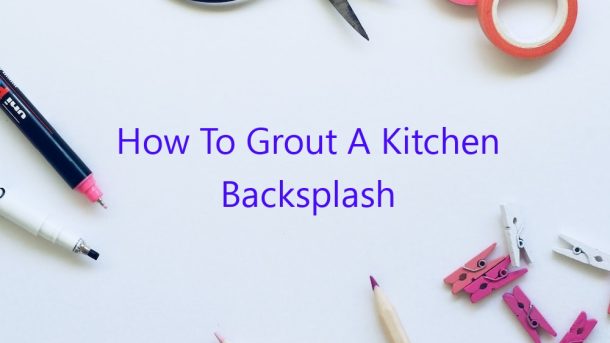A kitchen backsplash is a great way to add personality and style to your kitchen. One of the most important steps in installing a kitchen backsplash is grouting the tiles. Grouting the tiles will help to keep them in place and will give your kitchen backsplash a finished look.
The first step in grouting a kitchen backsplash is to apply a layer of grout to the tiles. You can use a rubber grout float to apply the grout. Be sure to apply the grout evenly and to press it into the cracks between the tiles.
The next step is to let the grout dry for a few hours. Once the grout has dried, you can start to wipe off the excess grout. You can use a damp sponge to wipe off the grout. Be sure to wipe off the grout in all of the cracks between the tiles.
The final step is to let the grout dry completely. Once the grout has dried, you can seal it with a grout sealer. Sealing the grout will help to protect it from staining and will help to keep it looking new.
By following these steps, you can grout your kitchen backsplash quickly and easily.
Contents [hide]
What is the best way to grout a backsplash?
There are a few different ways to grout a backsplash, and the best way for you will depend on your specific situation and preferences. In this article, we will discuss the different ways to grout a backsplash, and we will also provide advice on which method is best for you.
The first way to grout a backsplash is to use a premixed grout. This is a convenient option, as it is already mixed and ready to use. However, premixed grout can be difficult to work with, as it is often very thick.
Another option is to use mortar. Mortar is a type of cement that is mixed with sand and water. This option is more labor-intensive than using premixed grout, but it can be a good choice if you want to create a custom color or if you need to grout a particularly difficult space.
The third option is to use a grout bag. This is a bag that is filled with grout, and it allows you to apply the grout in a very controlled manner. This is a good option if you are worried about getting grout on your walls or cabinets.
Finally, you can also use epoxy grout. Epoxy grout is a type of grout that is made specifically for backsplashes. It is waterproof and very durable, and it is also resistant to staining and fading. Epoxy grout is a bit more expensive than other types of grout, but it is a good option if you want a high-quality finish.
So, which is the best way to grout a backsplash? The best way to grout a backsplash will depend on your individual situation and preferences. However, we would recommend using epoxy grout for the best results.
What kind of grout should be used for kitchen backsplash?
Tile grout is a specialized mortar used to fill the joints between tiles. When used in a kitchen backsplash, it is important to use a grout that is both durable and easy to clean.
There are many different types of grout available on the market, but the two most common types are epoxy grout and cement grout. Epoxy grout is a resin-based grout that is very durable and resistant to staining. Cement grout is a mortar that is made from sand, water, and Portland cement. It is less durable than epoxy grout, but it is less expensive and easier to use.
When choosing a grout for a kitchen backsplash, it is important to consider the material of the tiles. Epoxy grout is a good choice for glazed tiles, while cement grout is a better choice for unglazed tiles.
It is also important to choose a grout that is colorfast. Grout that is not colorfast can fade over time, which can spoil the appearance of the backsplash.
Finally, it is important to choose a grout that is easy to clean. Grout that is not easy to clean can become stained and difficult to remove. Epoxy grout is the best choice for a kitchen backsplash, because it is both durable and easy to clean.
Do you grout between backsplash and countertop?
There are a few different schools of thought on whether or not you should grout between your backsplash and countertop. Some people believe that it is necessary in order to keep the two areas from separating, while others feel that it is not necessary and can actually be a bit of a hassle. Let’s take a closer look at both sides of the argument.
On the one hand, grouting between your backsplash and countertop can definitely help to keep the two areas from separating. This is because grout is a pretty sturdy material, and it will help to keep the two areas in place. Additionally, grout can also help to prevent water and other liquids from seeping in between the two areas, which can lead to damage over time.
On the other hand, grouting between your backsplash and countertop can be a bit of a hassle. This is because it can be difficult to get the grout lines to look nice and even, and it can be a bit of a challenge to keep them clean. Additionally, grout can be a bit of a pain to maintain over time – it needs to be regularly cleaned and sealed in order to keep it looking its best.
So, what’s the verdict? In the end, it’s up to you whether or not you want to grout between your backsplash and countertop. If you think that grout will help to keep the two areas in place and prevent water damage, then it may be worth it to go ahead and use it. However, if you think that grout will be more of a hassle than it’s worth, then you may want to skip it.
How long do you leave grout before wiping down?
There is no one definitive answer to the question of how long you should wait before wiping down grout. Some factors that can affect the answer include the type of grout, the type of sealant used, the climate, and the amount of traffic the floor receives. In general, it is usually best to wait at least 24 hours before wiping down grout, but it may be necessary to wait longer in some cases.
Grout is a porous material, and it can take a while for it to fully dry. If the grout is not allowed to dry completely, it can become stained and difficult to clean. In addition, if the grout is not fully dry, it can be more susceptible to mold and mildew.
If you are unable to wait the full 24 hours before wiping down the grout, it is important to use a damp towel and avoid getting the grout wet. You should also avoid scrubbing the grout, as this can damage the sealant and make it more difficult to clean.
How long after grouting can you caulk?
Caulking is an important part of any tile installation. It helps to seal the tile and grout joints, preventing water and other debris from seeping behind the tiles and causing damage. Caulking should be applied shortly after grouting, while the grout is still wet.
How long you should wait to caulk after grouting depends on the type of caulk you are using. Most latex caulks should be applied within 24 hours, while silicone caulks can wait up to 72 hours. If you are using a hybrid caulk, follow the instructions on the package.
It’s important to use the right type of caulk for the job. Latex caulks are easy to use and relatively affordable, but they are not as durable as silicone caulks. Silicone caulks are more expensive, but they are more durable and can withstand greater water pressure. Hybrid caulks are a combination of latex and silicone, and they offer the best of both worlds.
When caulking, be sure to use a caulk gun to apply the caulk in a consistent, smooth line. Use a damp cloth to remove any excess caulk. Let the caulk dry for 24 hours before using the shower or bathtub.
Do you caulk before grouting?
If you’re wondering whether you should caulk before grouting ceramic tile, the answer is usually yes. Caulking helps to fill in any gaps between the tile and the substrate, whether that’s the wall or the floor. This helps to create a watertight seal and prevents moisture from seeping behind the tile.
There are a few things to keep in mind when caulking before grouting. First, be sure to use a quality caulk that is designed for use with tile. Second, make sure the surface is clean and dry before applying the caulk. Finally, be sure to caulk between the tile and the substrate, not between the tiles themselves.
If you’re not sure whether you should caulk before grouting, it’s always best to err on the side of caution and go ahead and do it. Caulking is a quick and easy process, and it can help to ensure that your tile installation looks great and lasts for years.
Should grout be darker or lighter than tile?
When it comes to choosing the color of grout for your tile, there are a few things to consider. The main question is whether to choose a color that is darker or lighter than the tile.
One thing to keep in mind is that grout is a very important part of the overall look of your tile installation. It can help to create a cohesive look, or it can stand out and become a focal point.
If you are going for a cohesive look, it is important to choose a color of grout that is similar to the color of the tile. This will help to create a smooth and unified look.
If you are looking for a more dramatic look, you may want to choose a color of grout that is darker than the tile. This will create a more striking effect and will help to add interest to the installation.
It is also worth noting that the color of the grout can affect the appearance of the tile. For example, if you choose a light color of grout, the tile may appear to be lighter as well. Conversely, if you choose a dark color of grout, the tile may appear to be darker.
In the end, the choice of whether to choose a darker or lighter color of grout is up to you. Just be sure to consider the overall look that you are trying to achieve, and choose a color of grout that will help to achieve that look.




